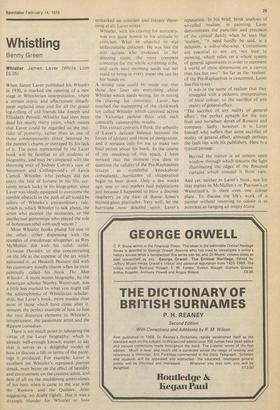Whistling
Benny Green
Whistler James Laver (White Lion £5.25)
When James Laver published his Whistler in 1930, it marked the opening of a new stage in Whistlerian interpretation, where a certain ironic and affectionate detachment replaced once and for all the genial log-rolling of old friends like Joseph and Elizabeth Pennell. Whistler had then been dead for nearly thirty years, which means that Laver could be regarded as the outrider of posterity, rather than as one of those contemporaries either besotted by the painter's charm or outraged by his lack of it. The point represented by the Laver book will be familiar to all students of biography, and may be compared with the throwing over of Sydney Colvin's view of Stevenson and Collingwood's of Lewis Carroll. Whistler, who perhaps did not enjoy the best of fortune in his life, certainly struck lucky in his biographer, since Laver was ideally equipped to overcome the terrible obstacle in the path of all would be tellers of Whistler's extraordinary tale, which is, which Whistler to talk about, the artist who painted the nocturnes, or the intellectual guttersnipe who played the role of bohemian rebel with such venom?
Most Whistler books plump for one or the other, either dispensing with the spangles of anecdotage altogether, as Roy McMullen did with his solid, stolid, Victorian Outsider, or else concentrating on the life at the expense of the art which sustained it, as Hesketh Pearson did with his customary wordly charm when he most pointedly called his book The Man Whistler. A more recent biography, by the American scholar Stanley Weintraub, was a little less marked by what you might call the schizophrenia of Whistlerian scholarship, but Laver's book, more modest than most of those which have come after it, remains the perfect example of how to fuse the two disparate elements in Whistler's temperament, the passionate artist and the flippant comedian.
There is not much point in labouring the virtue of the Laver biography, which is already well-enough known, except to say that it serves as a delightful model of how to discuss a life in terms of the paintings it produced. For example, Laver is excellent on Whistler's repressed puritan streak, even better on the effect of heredity and environment on the creative artist, and best of all on the maddening ambivalence of his hero when it came to the war with the Ruskins and the Quilters. After suggesting, no doubt rightly, that it was a strategic blunder for Whistler to have embarked on criticism and literary theorising at all, Laver writes: Whistler, with his craving for notoriety, was not quite honest in his attitude to criticism. What he objected to was unfavourable criticism. He was like the star actress who professes, in her dressing room, the most complete contempt for the whole scribbling tribe, and early next morning sends out her maid to' bring in every paper she can lay her hands on.
A strong case could be made out that those few lines say everything about Whistler which needs saying, for in noting the craving for notoriety, Laver has touched the mainspring of the clockwork toy called Whistler which careened across the Victorian parlour floor with such comically catastrophic results.
This extract conveys, I think, the urbanity of Laver's delicate balance between the forces of idolatry and those of denigration, and it remains only for me to make two final points about his book. In the course of my residence of this space, I have noticed that the moment you dare to question the validity of the Pre-Raphaelites (except as wonderful knockabout comedians), hurricanes of vituperation begin to bear down. Only a few weeks ago, one or two readers had palpitations just because I happened to blow a discreet raspberry ?in the face of Burne Jones's stained-glass platitudes. Very well; let the hurricane now descend upon Layer's reputation. In his brief, brisk analysis of so-called 'realism' in painting, Laver demonstrates the punctilio and precision of the critical dandy when he says that 'realism,' "it need hardly be said, is a delusion, a will-o'-the-wisp. Conventions are essential to any art, not least to painting, which relies on a whole system of general agreements in order to represent a world of three dimensions on a canvas that has but two". So far as the 'realism' of the Pre-Raphaelites is concerned, Laver has this to say: It was in the name of realism that they struggled with a pedantic interpretation of local colour, to the sacrifice of any reality of general effect.
"The sacrifice of any reality of general effect", the perfect epitaph for the wax fruit and horsehair doves of Rossetti arid company. Sadly, however, it is Laver himself who suffers that same sacrifice of reality of general effect, although perhaps the fault lies with his publishers. Here is a typical passage: Beyond the mirror is an unseen open window through which streams the light illuminating the edges of the flowered curtains which conceal it from view.
And yet, neither in Layer's book, nor for that matter in McMullen's or Pearson's or Weintraub's, is there even one colour plate. To discuss the life's work of a painter without resorting to colour is as pointless as hanging an empty frame.


































 Previous page
Previous page